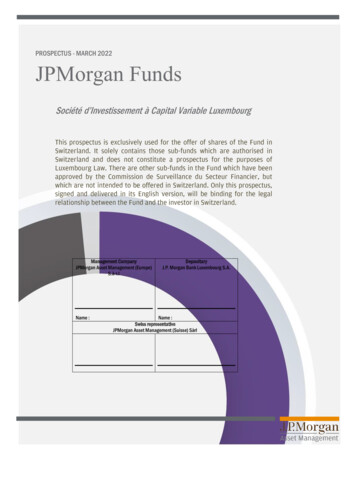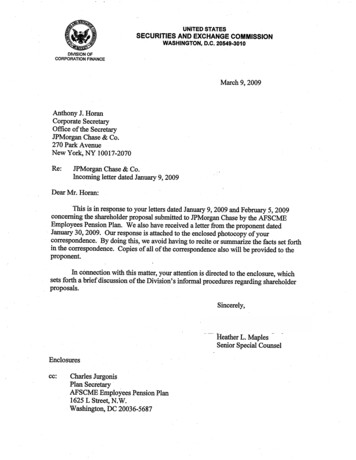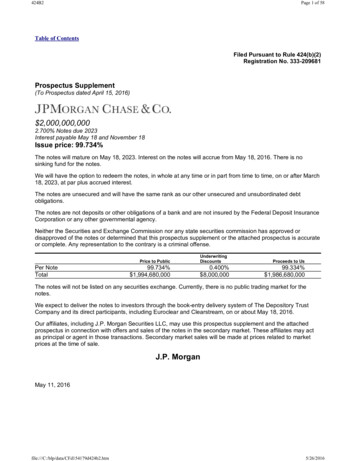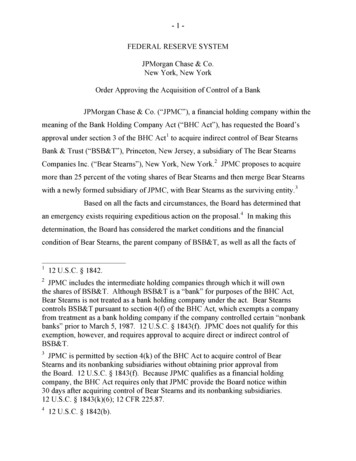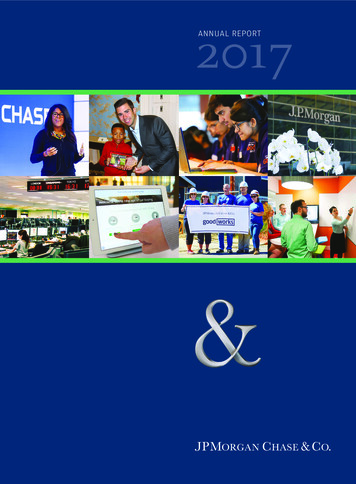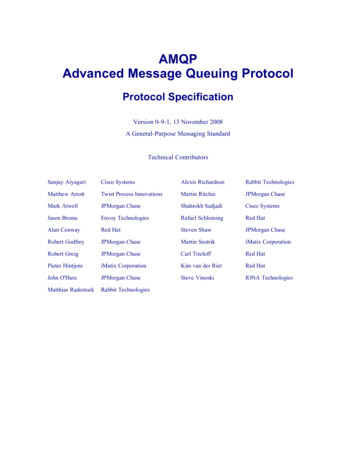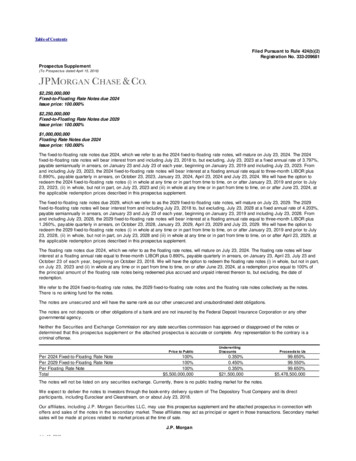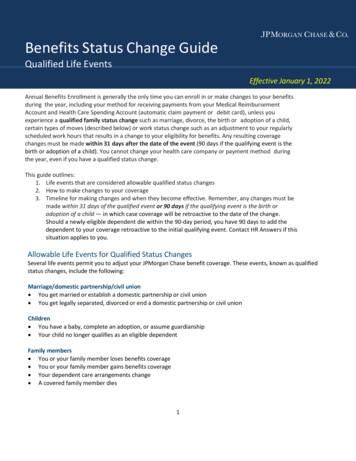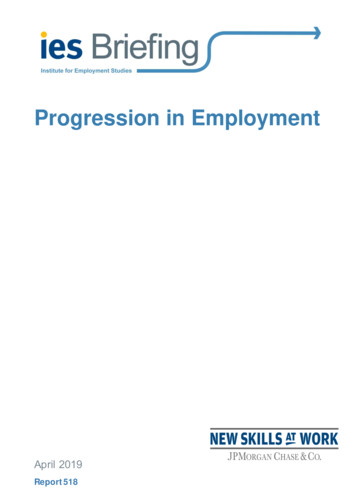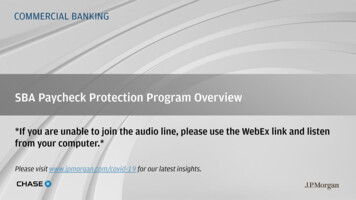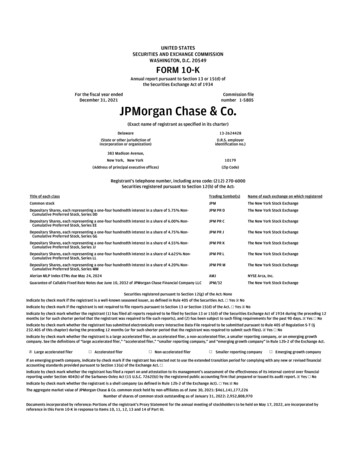
Transcription
UNITED STATESSECURITIES AND EXCHANGE COMMISSIONWASHINGTON, D.C. 20549FORM 10-KAnnual report pursuant to Section 13 or 15(d) ofthe Securities Exchange Act of 1934For the fiscal year endedDecember 31, 2021Commission filenumber 1-5805JPMorgan Chase & Co.(Exact name of registrant as specified in its charter)Delaware13-2624428(State or other jurisdiction ofincorporation or organization)(I.R.S. employeridentification no.)383 Madison Avenue,New York, New York10179(Address of principal executive offices)(Zip Code)Registrant’s telephone number, including area code: (212) 270-6000Securities registered pursuant to Section 12(b) of the Act:Title of each classTrading Symbol(s)Name of each exchange on which registeredCommon stockJPMThe New York Stock ExchangeDepositary Shares, each representing a one-four hundredth interest in a share of 5.75% NonCumulative Preferred Stock, Series DDJPM PR DThe New York Stock ExchangeDepositary Shares, each representing a one-four hundredth interest in a share of 6.00% NonCumulative Preferred Stock, Series EEJPM PR CThe New York Stock ExchangeDepositary Shares, each representing a one-four hundredth interest in a share of 4.75% NonCumulative Preferred Stock, Series GGJPM PR JThe New York Stock ExchangeDepositary Shares, each representing a one-four hundredth interest in a share of 4.55% NonCumulative Preferred Stock, Series JJJPM PR KThe New York Stock ExchangeDepositary Shares, each representing a one-four hundredth interest in a share of 4.625% NonCumulative Preferred Stock, Series LLJPM PR LThe New York Stock ExchangeDepositary Shares, each representing a one-four hundredth interest in a share of 4.20% NonCumulative Preferred Stock, Series MMJPM PR MThe New York Stock ExchangeAlerian MLP Index ETNs due May 24, 2024AMJNYSE Arca, Inc.Guarantee of Callable Fixed Rate Notes due June 10, 2032 of JPMorgan Chase Financial Company LLCJPM/32The New York Stock ExchangeSecurities registered pursuant to Section 12(g) of the Act: NoneIndicate by check mark if the registrant is a well-known seasoned issuer, as defined in Rule 405 of the Securities Act. Yes NoIndicate by check mark if the registrant is not required to file reports pursuant to Section 13 or Section 15(d) of the Act. Yes NoIndicate by check mark whether the registrant (1) has filed all reports required to be filed by Section 13 or 15(d) of the Securities Exchange Act of 1934 during the preceding 12months (or for such shorter period that the registrant was required to file such reports), and (2) has been subject to such filing requirements for the past 90 days. Yes NoIndicate by check mark whether the registrant has submitted electronically every Interactive Data File required to be submitted pursuant to Rule 405 of Regulation S-T (§232.405 of this chapter) during the preceding 12 months (or for such shorter period that the registrant was required to submit such files). Yes NoIndicate by check mark whether the registrant is a large accelerated filer, an accelerated filer, a non-accelerated filer, a smaller reporting company, or an emerging growthcompany. See the definitions of “large accelerated filer,” “accelerated filer,” “smaller reporting company,” and “emerging growth company” in Rule 12b-2 of the Exchange Act. Large accelerated filer Accelerated filer Non-accelerated filer Smaller reporting company Emerging growth companyIf an emerging growth company, indicate by check mark if the registrant has elected not to use the extended transition period for complying with any new or revised financialaccounting standards provided pursuant to Section 13(a) of the Exchange Act. Indicate by check mark whether the registrant has filed a report on and attestation to its management’s assessment of the effectiveness of its internal control over financialreporting under Section 404(b) of the Sarbanes-Oxley Act (15 U.S.C. 7262(b)) by the registered public accounting firm that prepared or issued its audit report. Yes NoIndicate by check mark whether the registrant is a shell company (as defined in Rule 12b-2 of the Exchange Act). Yes NoThe aggregate market value of JPMorgan Chase & Co. common stock held by non-affiliates as of June 30, 2021: 461,141,177,226Number of shares of common stock outstanding as of January 31, 2022: 2,952,808,970Documents incorporated by reference: Portions of the registrant’s Proxy Statement for the annual meeting of stockholders to be held on May 17, 2022, are incorporated byreference in this Form 10-K in response to Items 10, 11, 12, 13 and 14 of Part III.
Form 10-K IndexPart IItem 1.PageBusiness. . . . . . . . . . . . . . . . . . . . . . . . . . . . . . . . . . . . . . . . . . . . . . . . . . . . . . . . . . . . . . . . . . . . . . . . . . . . .1Overview . . . . . . . . . . . . . . . . . . . . . . . . . . . . . . . . . . . . . . . . . . . . . . . . . . . . . . . . . . . . . . . . . . . . . . . . . . .1Business segments . . . . . . . . . . . . . . . . . . . . . . . . . . . . . . . . . . . . . . . . . . . . . . . . . . . . . . . . . . . . . . . . . . .1Competition . . . . . . . . . . . . . . . . . . . . . . . . . . . . . . . . . . . . . . . . . . . . . . . . . . . . . . . . . . . . . . . . . . . . . . . .1Human capital . . . . . . . . . . . . . . . . . . . . . . . . . . . . . . . . . . . . . . . . . . . . . . . . . . . . . . . . . . . . . . . . . . . . . . .2-3Supervision and regulation . . . . . . . . . . . . . . . . . . . . . . . . . . . . . . . . . . . . . . . . . . . . . . . . . . . . . . . . . . . . .4-8Distribution of assets, liabilities and stockholders’ equity; interest rates and interest differentials . . . . .300-30444, 160, 300Return on equity and assets . . . . . . . . . . . . . . . . . . . . . . . . . . . . . . . . . . . . . . . . . . . . . . . . . . . . . . . . . . . .Investment securities portfolio . . . . . . . . . . . . . . . . . . . . . . . . . . . . . . . . . . . . . . . . . . . . . . . . . . . . . . . . . .220Loans . . . . . . . . . . . . . . . . . . . . . . . . . . . . . . . . . . . . . . . . . . . . . . . . . . . . . . . . . . . . . . . . . . . . . . . . . . . . .108-128, 229-247Allowance for credit losses . . . . . . . . . . . . . . . . . . . . . . . . . . . . . . . . . . . . . . . . . . . . . . . . . . . . . . . . . . . . .129-131, 248-252Deposits . . . . . . . . . . . . . . . . . . . . . . . . . . . . . . . . . . . . . . . . . . . . . . . . . . . . . . . . . . . . . . . . . . . . . . . . . . .265Item 1A.Risk Factors. . . . . . . . . . . . . . . . . . . . . . . . . . . . . . . . . . . . . . . . . . . . . . . . . . . . . . . . . . . . . . . . . . . . . . . . . .9-33Item 1B.Unresolved Staff Comments. . . . . . . . . . . . . . . . . . . . . . . . . . . . . . . . . . . . . . . . . . . . . . . . . . . . . . . . . . . . . .34Item 2.Properties. . . . . . . . . . . . . . . . . . . . . . . . . . . . . . . . . . . . . . . . . . . . . . . . . . . . . . . . . . . . . . . . . . . . . . . . . . . .34Item 3.Legal Proceedings. . . . . . . . . . . . . . . . . . . . . . . . . . . . . . . . . . . . . . . . . . . . . . . . . . . . . . . . . . . . . . . . . . . . .34Item 4.Mine Safety Disclosures. . . . . . . . . . . . . . . . . . . . . . . . . . . . . . . . . . . . . . . . . . . . . . . . . . . . . . . . . . . . . . . . .34Item 6.Market for Registrant’s Common Equity, Related Stockholder Matters and Issuer Purchases of EquitySecurities. . . . . . . . . . . . . . . . . . . . . . . . . . . . . . . . . . . . . . . . . . . . . . . . . . . . . . . . . . . . . . . . . . . . . . . . . . .Reserved . . . . . . . . . . . . . . . . . . . . . . . . . . . . . . . . . . . . . . . . . . . . . . . . . . . . . . . . . . . . . . . . . . . . . . . . . . . .3535Item 7.Management’s Discussion and Analysis of Financial Condition and Results of Operations. . . . . . . . . . . . . .35Item 7A.Quantitative and Qualitative Disclosures About Market Risk. . . . . . . . . . . . . . . . . . . . . . . . . . . . . . . . . . . . .36Item 8.Financial Statements and Supplementary Data. . . . . . . . . . . . . . . . . . . . . . . . . . . . . . . . . . . . . . . . . . . . . . .36Item 9.Changes in and Disagreements with Accountants on Accounting and Financial Disclosure. . . . . . . . . . . . .36Item 9A.Controls and Procedures. . . . . . . . . . . . . . . . . . . . . . . . . . . . . . . . . . . . . . . . . . . . . . . . . . . . . . . . . . . . . . . .36Item 9B.Other Information. . . . . . . . . . . . . . . . . . . . . . . . . . . . . . . . . . . . . . . . . . . . . . . . . . . . . . . . . . . . . . . . . . . . . .36Item 9C.Disclosure regarding Foreign Jurisdictions that Prevent Inspections. . . . . . . . . . . . . . . . . . . . . . . . . . . . . .36Part IIIItem 10.Directors, Executive Officers and Corporate Governance. . . . . . . . . . . . . . . . . . . . . . . . . . . . . . . . . . . . . . .37Item 11.Executive Compensation. . . . . . . . . . . . . . . . . . . . . . . . . . . . . . . . . . . . . . . . . . . . . . . . . . . . . . . . . . . . . . . . .38Item 12.Security Ownership of Certain Beneficial Owners and Management and Related Stockholder Matters. . . .38Item 13.Certain Relationships and Related Transactions, and Director Independence. . . . . . . . . . . . . . . . . . . . . . .38Item 14.Principal Accounting Fees and Services. . . . . . . . . . . . . . . . . . . . . . . . . . . . . . . . . . . . . . . . . . . . . . . . . . . . .38Exhibits, Financial Statement Schedules. . . . . . . . . . . . . . . . . . . . . . . . . . . . . . . . . . . . . . . . . . . . . . . . . . . .39-42Part IIItem 5.Part IVItem 15.
Part IItem 1. Business.OverviewJPMorgan Chase & Co. (“JPMorgan Chase” or the “Firm”,NYSE: JPM), a financial holding company incorporatedunder Delaware law in 1968, is a leading financial servicesfirm based in the United States of America (“U.S.”), withoperations worldwide. JPMorgan Chase had 3.7 trillion inassets and 294.1 billion in stockholders’ equity as ofDecember 31, 2021. The Firm is a leader in investmentbanking, financial services for consumers and smallbusinesses, commercial banking, financial transactionprocessing and asset management. Under the J.P. Morganand Chase brands, the Firm serves millions of customers,predominantly in the U.S., and many of the world’s mostprominent corporate, institutional and government clientsglobally.Business segmentsFor management reporting purposes, JPMorgan Chase’sactivities are organized into four major reportable businesssegments, as well as a Corporate segment. The Firm’sconsumer business is the Consumer & Community Banking(“CCB”) segment. The Firm’s wholesale business segmentsare the Corporate & Investment Bank (“CIB”), CommercialBanking (“CB”), and Asset & Wealth Management (“AWM”).JPMorgan Chase’s principal bank subsidiary is JPMorganChase Bank, National Association (“JPMorgan Chase Bank,N.A.”), a national banking association with U.S. branches in48 states and Washington, D.C. as of December 31, 2021.JPMorgan Chase’s principal non-bank subsidiary is J.P.Morgan Securities LLC (“J.P. Morgan Securities”), a U.S.broker-dealer. The bank and non-bank subsidiaries ofJPMorgan Chase operate nationally as well as throughoverseas branches and subsidiaries, representative officesand subsidiary foreign banks. The Firm’s principal operatingsubsidiary outside the U.S. is J.P. Morgan Securities plc, aU.K.-based subsidiary of JPMorgan Chase Bank, N.A.CompetitionJPMorgan Chase and its subsidiaries and affiliates operatein highly competitive environments. Competitors includeother banks, brokerage firms, investment bankingcompanies, merchant banks, hedge funds, commoditytrading companies, private equity firms, insurancecompanies, mutual fund companies, investment managers,credit card companies, mortgage banking companies, trustcompanies, securities processing companies, automobilefinancing companies, leasing companies, e-commerce andother internet-based companies, financial technologycompanies, and other companies engaged in providingsimilar and new products and services. The Firm’sbusinesses generally compete on the basis of the qualityand variety of the Firm’s products and services, transactionexecution, innovation, reputation and price. Competitionalso varies based on the types of clients, customers,industries and geographies served. With respect to some ofits geographies and products, JPMorgan Chase competesglobally; with respect to others, the Firm competes on anational or regional basis. New competitors in the financialservices industry continue to emerge, including firms thatoffer products and services solely through the internet andnon-financial companies that offer payment or loanproducts.The Firm’s website is www.jpmorganchase.com. JPMorganChase makes available on its website, free of charge, annualreports on Form 10-K, quarterly reports on Form 10-Q andcurrent reports on Form 8-K pursuant to Section 13(a) orSection 15(d) of the Securities Exchange Act of 1934, assoon as reasonably practicable after it electronically files orfurnishes such material to the U.S. Securities and ExchangeCommission (the “SEC”) at www.sec.gov. JPMorgan Chasemakes new and important information about the Firmavailable on its website at https://www.jpmorganchase.com, including on the InvestorRelations section of its website at https://www.jpmorganchase.com/ir. Information on the Firm'swebsite is not incorporated by reference into this 2021Form 10-K or the Firm’s other filings with the SEC. The Firmhas adopted, and posted on its website, a Code of Conductfor all employees of the Firm and a Code of Ethics for itsChairman and Chief Executive Officer, Chief FinancialOfficer, Principal Accounting Officer and all otherprofessionals of the Firm worldwide serving in a finance,accounting, treasury, tax or investor relations role.A description of the Firm’s business segments and theproducts and services they provide to their respective clientbases is provided in the “Business segment results” sectionof Management’s discussion and analysis of financialcondition and results of operations (“Management’sdiscussion and analysis” or “MD&A”), beginning on page 46and in Note 32.1
Part IHuman capitalJPMorgan Chase believes that its long-term growth and success depend on its ability to attract, develop and retain a highperforming and diverse workforce, with inclusion and accessibility as key components of the way the Firm does business. Theinformation provided below relates to JPMorgan Chase’s full-time and part-time employees and does not include the Firm’scontractors.Global workforceAs of December 31, 2021, JPMorgan Chase had 271,025 employees globally, an increase of 15,674 employees from the prioryear. The Firm’s employees are located in 62 countries, with over 60% of the Firm’s employees located in the U.S. Thefollowing table presents the distribution of the Firm’s global workforce by region and by LOB and Corporate as of December31, 2021:Employee Breakdown by RegionRegionNorth AmericaEmployee Breakdown by LOB and 260CIB67,546Latin M22,762Total Firm271,025Corporate38,952Total Firm271,025Europe/Middle East/AfricaDiversity, equity and inclusionIn connection with its diversity initiatives, the Firm periodically requests that its employees and Board members self-identifybased on specified diversity categories. The following table presents information on self-identifications as of December 31,2021. The information according to Equal Employment Opportunity (“EEO”) race/ethnicity categories and gender is based onU.S. and global employees, respectively, who self-identified. Race/ethnicity and gender information reflects all members of theOperating Committee and the Board of Directors. Information on LGBT and veteran statuses is based on U.S. employees, andall members of the Operating Committee and the Board of Directors. Information on disability status is based on all U.S.employees and all members of the Operating Committee.TotalemployeesSenior levelemployees(e)OperatingCommitteeBoard 51%74%63%60%Women49%26%37%40%4%2%5%—Military veterans3%2%——People with disabilities(d)4%2%——December 31, 2021Race/Ethnicity(a):Gender(c):LGBT (d)(d)(f)(a) Based on EEO metrics. Presented as a percentage of the respective populations who self-identified race/ethnicity: 96% and 95% of the Firm’s total U.S.based employees and U.S.-based senior level employees, respectively, and all members of the Operating Committee and the Board of Directors.Information for the Operating Committee includes two members who are based outside of the U.S.(b) Other includes American Indian or Alaskan Native, Native Hawaiian or Other Pacific Islander, and two or more races/ethnicities.(c) Presented as a percentage of the respective populations who self-identified gender: 99% of each of the Firm’s total global employees and global seniorlevel employees, and all members of the Operating Committee and the Board of Directors.(d) Presented as a percentage of total U.S.-based employees, total U.S.-based senior level employees, all members of the Operating Committee, and allmembers of the Board of Directors, respectively.(e) Senior level employees represents employees with the titles of Managing Director and above.(f) The Firm did not request members of the Board of Directors to self-identify disability status.2
Firm cultureThe foundations of JPMorgan Chase’s culture are its corevalues and How We Do Business Principles, which arefundamental to the Firm’s success and are represented byfour central corporate tenets: exceptional client service;operational excellence; a commitment to integrity, fairnessand responsibility; and cultivation of a great team andwinning culture. The Firm maintains its focus on its cultureof inclusion and respect, which is reinforced by its Code ofConduct and through increasing employee awareness andeducation, communication and training. An important partof these efforts includes the Firm’s Business ResourceGroups, which are groups of employees who supportJPMorgan Chase’s diversity, equity and inclusion strategiesby leveraging the unique perspectives of their members.The Firm has global Diversity, Equity & Inclusion centers ofexcellence, several of which were launched in 2021, thatlead the Firm’s strategy in supporting its commitments tocreate more equity and lasting impact in communities, andstrengthen its inclusive culture.Attracting and retaining employeesThe goal of JPMorgan Chase’s recruitment efforts is toattract and hire talented individuals in all roles and at allcareer levels. The Firm strives to provide both externalcandidates and internal employees who are seeking adifferent role with challenging and stimulating careeropportunities. These opportunities range from internshiptraining programs for students to entry-level, managementand executive careers. During 2021, approximately twothirds of the Firm’s employment opportunities were filledby external candidates, with the remainder filled by existingemployees.Diversity is an important area of focus throughout theFirm’s hiring process. JPMorgan Chase engages in effortsaimed at hiring diverse talent, including initiatives focusedon gender, underrepresented ethnic groups, LGBT individuals, people with disabilities, veterans and others.The Firm’s global Diversity, Equity & Inclusion centers ofexcellence seek to increase representation of and advancecareer opportunities for talented diverse individuals acrossthe Firm through initiatives such as career coaching andmentorship.Developing employeesJPMorgan Chase supports the professional developmentand career growth of its employees. An onboarding trainingcurriculum is required for new hires, which covers Code ofConduct, compliance and cybersecurity, among othertopics. In addition, the Firm offers extensive trainingprograms to all employees, covering a broad variety oftopics such as leadership, change management, analyticalthinking, culture and conduct, diversity, equity andinclusion, and risk and controls. Leadership Edge, the Firm’sglobal leadership development Center of Excellence, isfocused on creating one Firm leadership culture.Compensation and benefitsThe Firm provides market-competitive compensation andbenefits programs. JPMorgan Chase’s compensationphilosophy provides the guiding principles that drivecompensation-related decisions across the Firm, includingpay-for-performance, responsiveness and alignment withshareholder interests, reinforcement of the Firm’s cultureand How We Do Business Principles, and integration of risk,controls and conduct considerations. The Firm’scommitment to diversity, equity and inclusion for allemployees includes compensation review processes thatseek to ensure that the Firm’s employees are paid equitablyand competitively for the work they do.The Firm also supports employees’ well-being. JPMorganChase offers an extensive benefits and wellness package toemployees and their families, including healthcarecoverage, retirement benefits, life and disability insurance,on-site health and wellness centers, employee assistanceprograms, competitive vacation and leave policies, backupchild care arrangements, tuition reimbursement programs,mental health counseling and support, and financialcoaching. The Firm has taken action to protect and supportits employees during the COVID-19 pandemic, includingcontinued implementation of health and safety protocols,and providing additional benefits. For more information onthe Firm’s response to the COVID-19 pandemic, refer toBusiness Developments on page 50.JPMorgan Chase offers a competitive fellowship programthat seeks to attract accomplished individuals who havetaken a career break and wish to return to the workforce.In addition, where appropriate, the Firm’s hiring practicesfocus on the skills of a job candidate rather than degreesheld.3
Part ISupervision and regulationThe Firm is subject to extensive and comprehensiveregulation under U.S. federal and state laws, as well as theapplicable laws of the jurisdictions outside the U.S. in whichthe Firm does business.Financial holding company:Consolidated supervision. JPMorgan Chase & Co. is a bankholding company (“BHC”) and a financial holding company(“FHC”) under U.S. federal law, and is subject tocomprehensive consolidated supervision, regulation andexamination by the Board of Governors of the FederalReserve System (the “Federal Reserve”). The FederalReserve acts as the supervisor of the consolidatedoperations of BHCs. Certain of JPMorgan Chase’ssubsidiaries are also regulated directly by additionalauthorities based on the activities or licenses of thosesubsidiaries.JPMorgan Chase’s national bank subsidiary, JPMorganChase Bank, N.A., is supervised and regulated by the Officeof the Comptroller of the Currency (“OCC”) and, withrespect to certain matters, by the Federal Deposit InsuranceCorporation (the “FDIC”).JPMorgan Chase’s U.S. broker-dealers are supervised andregulated by the Securities and Exchange Commission(“SEC”) and the Financial Industry Regulatory Authority(“FINRA”). Subsidiaries of the Firm that engage in certainfutures-related and swaps-related activities are supervisedand regulated by the Commodity Futures TradingCommission (“CFTC”). J.P. Morgan Securities plc is a U.K.based bank regulated by the U.K. Prudential RegulationAuthority (the “PRA”) and the U.K. Financial ConductAuthority (“FCA”).The Firm’s other non-U.S. subsidiaries are regulated by thebanking, securities, prudential and conduct regulatoryauthorities in the countries in which they operate.Permissible business activities. The Bank Holding CompanyAct restricts BHCs from engaging in business activities otherthan the business of banking and certain closely-relatedactivities. FHCs can engage in a broader range of financialactivities. The Federal Reserve has the authority to limit anFHC’s ability to conduct otherwise permissible activities ifthe FHC or any of its depository institution subsidiariesceases to meet applicable eligibility requirements. TheFederal Reserve may also impose corrective capital and/ormanagerial requirements on the FHC, and if deficiencies arepersistent, may require divestiture of the FHC’s depositoryinstitutions. If any depository institution controlled by anFHC fails to maintain a satisfactory rating under theCommunity Reinvestment Act, the Federal Reserve mustprohibit the FHC and its subsidiaries from engaging in anynew activities other than those permissible for BHCs, oracquiring a company engaged in such activities.Capital and liquidity requirements. The Federal Reserveestablishes capital, liquidity and leverage requirements forJPMorgan Chase that are generally consistent with the4international Basel III capital and liquidity framework andevaluates the Firm’s compliance with those requirements.The OCC establishes similar requirements for JPMorganChase Bank, N.A. Certain of the Firm’s non-U.S. subsidiariesand branches are also subject to local capital and liquidityrequirements.Banking supervisors globally continue to refine andenhance the Basel III capital framework for financialinstitutions. In January 2019, the Basel Committee issued“Minimum capital requirements for market risk.” The BaselCommittee expects national regulators to implement theserevised market risk requirements for banking organizationsin their jurisdictions by January 2023, in line with the otherelements of the Basel III Reforms. U.S. banking regulatorshave announced their support for the issuance of the BaselIII Reforms and are considering how to appropriately applysuch reforms in the U.S.Refer to Capital Risk Management on pages 86-96 andLiquidity Risk Management on pages 97-104 .Stress tests. As a large BHC, JPMorgan Chase is subject tosupervisory stress testing administered by the FederalReserve as part of the Federal Reserve’s annualComprehensive Capital Analysis and Review (“CCAR”)framework. The Firm must conduct annual company-runstress tests and must also submit an annual capital plan tothe Federal Reserve, taking into account the results ofseparate stress tests designed by the Firm and the FederalReserve. The Federal Reserve uses the results under theseverely adverse scenario from its supervisory stress test todetermine the Firm’s Stress Capital Buffer (“SCB”)requirement for the coming year, which forms part of theFirm’s applicable capital buffers. The Firm is required to fileits annual CCAR submission on April 5, 2022. The FederalReserve will notify the Firm of its indicative SCBrequirement by June 30, 2022 and final SCB requirementby August 31, 2022. The Firm’s final SCB requirement willbecome effective on October 1, 2022. The OCC requiresJPMorgan Chase Bank, N.A. to perform separate, similarstress tests annually. The Firm publishes each year theresults of the annual stress tests for the Firm and JPMorganChase Bank, N.A. under the supervisory “severely adverse”scenarios provided by the Federal Reserve and the OCC.Refer to Capital Risk Management on pages 86-96 for moreinformation concerning the Firm’s CCAR.Enhanced prudential standards. As part of its mandate toidentify and monitor risks to the financial stability of theU.S. posed by large banking organizations, the FinancialStability Oversight Council (“FSOC”) recommendsprudential standards and reporting requirements to theFederal Reserve for systemically important financialinstitutions (“SIFIs”), such as JPMorgan Chase. The FederalReserve has adopted several rules to implement thoseheightened prudential standards, including rules relating torisk management and corporate governance of subjectBHCs. JPMorgan Chase is required under these rules tocomply with enhanced liquidity and overall risk
management standards, including oversight by the board ofdirectors of risk management activities.Resolution and recovery. The Firm is required to maintain acomprehensive recovery plan, updated annually,summarizing the actions it would take to avoid failure byremaining well-capitalized and well-funded in the case of anadverse event. In addition, JPMorgan Chase Bank, N.A. isrequired to prepare and submit a recovery plan as directedby the OCC. The Firm is required to submit periodically tothe Federal Reserve and the FDIC a plan for resolution inthe event of material distress or failure (a “resolutionplan”). In 2019, the FDIC and Federal Reserve revised theregulations governing resolution plan requirements, and onthe basis of those revisions, the Firm’s resolution plansubmissions will alternate between “targeted” and “full”plans. The Firm’s “targeted” resolution plan was filed onJune 28, 2021. JPMorgan Chase Bank, N.A. is also requiredto prepare and submit a separate resolution plan asdirected by the FDIC.Certain of the Firm’s non-U.S. subsidiaries and branches arealso subject to local resolution and recovery planningrequirements.Orderly liquidation authority. Certain financial companies,including JPMorgan Chase and certain of its subsidiaries,can also be subjected to resolution under an “orderlyliquidation authority.” The U.S. Treasury Secretary, inconsultation with the President of the United States, mustfirst make certain determinations concerning extraordinaryfinancial distress and systemic risk, and action must berecommended by the FDIC and the Federal Reserve. Absentsuch actions, the Firm, as a BHC, would remain subject toresolution under the Bankruptcy Code. The FDIC has issueda draft policy statement describing its “single point ofentry” strategy for resolution of SIFIs under the orderlyliquidation authority, which seeks to keep operatingsubsidiaries of a BHC open and impose losses onshareholders and creditors of the BHC in receivershipaccording to their statutory order of priority.Holding company as a source of strength. JPMorgan Chase &Co. is required to serve as a source of financial strength forits depository institutio
Chase Bank, National Association ("JPMorgan Chase Bank, N.A."), a national banking association with U.S. branches in 48 states and Washington, D.C. as of December 31, 2021. JPMorgan Chase's principal non-bank subsidiary is J.P. Morgan Securities LLC ("J.P. Morgan Securities"), a U.S. broker-dealer. The bank and non-bank subsidiaries .
